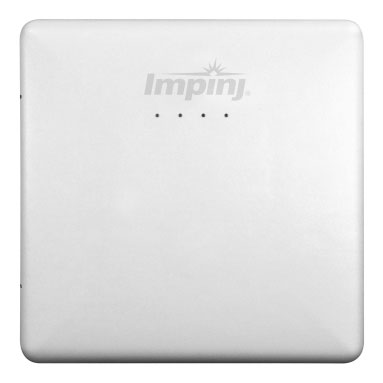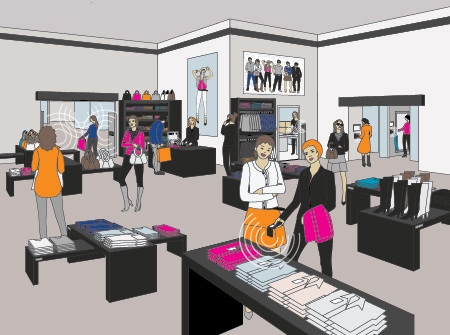Impinj’s Octane 5.4 Update for Fixed RFID Readers
 Impinj has announced the availability of the new Octane 5.4, firmware that enables Speedway, xArray, and xPortal readers to access LLRP data from RAIN RFID tags. Octane 5.4 firmware is now available for Impinj authorized partners and our customers that have Enhanced Maintenance. All other users should contact the company their reader was purchased from to request firmware updates. In this update, several new features were added to the firmware based on customer feedback. Also based on feedback, Impinj graduated the Octane Java SDK from beta status.
Impinj has announced the availability of the new Octane 5.4, firmware that enables Speedway, xArray, and xPortal readers to access LLRP data from RAIN RFID tags. Octane 5.4 firmware is now available for Impinj authorized partners and our customers that have Enhanced Maintenance. All other users should contact the company their reader was purchased from to request firmware updates. In this update, several new features were added to the firmware based on customer feedback. Also based on feedback, Impinj graduated the Octane Java SDK from beta status.
Updates in Octane 5.4 include:
- Expanded RAIN RFID tag tracking functionality with Impinj xArray tag direction mode.
- Get entry, update, and exit reports for tags as they move through designated sectors via Octane Java SDK 1.2
- Enhanced security profiles to protect your reader.
- Require readers to authenticate to gain network access using standards based 802.1x.
- Leverage SFTP to protect upgrades by authenticating to a remote server and ensuring secure transport of files.
- Encrypt Customer Application Partition (CAP) files to secure embedded applications.
For assistance updating to Octane 5.4 or finding the right Impinj RFID reader, contact one of our RFID specialists at Barcodes, Inc.
Item Intelligence & The Shopper’s Journey
 For brick and mortar retailers to stay competitive in today’s ever-changing retail landscape, they must begin to use powerful in-store technologies that enable the management of store inventory assets, the creation of engaging digital customer experiences, and the collection of valuable data.
For brick and mortar retailers to stay competitive in today’s ever-changing retail landscape, they must begin to use powerful in-store technologies that enable the management of store inventory assets, the creation of engaging digital customer experiences, and the collection of valuable data.
Engaging customer experiences can be implemented at all steps of the buying journey. While the traditional shopper’s journey has followed a path of go, search, learn, try, buy and get, the shift to omni-channel retailing and the rise of mobile device shopping has allowed each shopper’s journey to become unique and personal. Because of this, retailers must now integrate digital experiences into physical locations, keeping customers engaged while shopping in store and enabling the collection of data, much like the data collected when customers visit an eCommerce website. To do this, retailers must introduce Item Intelligence into their business strategy.
QuikQ Installs More Than 1,000 UHF RFID Systems At Fueling Stations

QuikQ has announced that it has installed more than 1,000 of its SmartQ systems at truck stops and travel centers throughout the United States. The SmartQ cardless fueling system leverages EPC Gen 2 passive ultrahigh-frequency (UHF) RFID tags (employing Impinj Monza 4 RFID chips) that can be affixed to trucks or trailers so that the vehicles can be identified while pulling into fuel lanes at truck stops. Once a vehicle is identified via an Impinj reader wired to as many as to four antennas mounted above the lanes, the system can automatically identify that truck, after which its driver can begin fueling without having to swipe a card or enter data on the pump’s keypad.
Love’s Travel Stops and Country Stores has implemented the system at more than 200 of its fuel stations to date. TravelCenters of America (which operates 165 sites) has also installed the solution, QuickQ adds, and is nearly finished with that deployment. In addition, QuikQ reports, many independent truck stops and travel centers are utilizing its SmartQ system. Acknowledging QuikQ’s growth, Impinj named the company its North American VAR Partner of the Year.
Why Use RFID Technology for Baggage Handling?
Most airlines struggle day to day with a variety of issues related to survival—issues such as unpredictable fuel costs, uncertain global economies, and tight finances. To combat these challenges, airlines continuously seek to better their operations, and RFID technology is at the forefront of process improvement.
RFID technology can aid and assist in multiple areas to reduce costs and increase operating revenue through improved asset visibility, consumable inventory management, food and beverage delivery management, retail item inventory, sales management, and baggage handling efficiency. This white paper addresses baggage handling specificaly.
Estimates by the International Air Transport Association (IATA) put mishandled baggage costs at approximately $US 2.5 billion for 2009 alone-equivalent to the cost of nearly 50 Boeing 737-600s. This industry problem spans cities, regions and continents. While many assume full participation by all parties is necessary to completely rectify the problem, RFID-enabled baggage tagging efforts already in place show that local or regional implementation of RFID on baggage can have significant benefit, resulting in improved service, substantial cost reductions or savings, and increased customer satisfaction.
RFID Chip-Based Serialization for Retail
An alternative to IT solutions for managing item-level tagging
Item-level radio frequency identification (RFID) using standard Electronic Product Codes (EPCs) is rapidly becoming a key factor in improving retail inventory management. The main driver for adoption is quite simple—taking inventory with RFID is 25 times faster than with bar codes. RFID is faster for two reasons. First, it does not require line of sight access to the tag. Second, the person operating the reader does not have to ensure that they only scanned each tag once.
The key difference is that RFID uses radio waves to count large numbers of tags simultaneously, even if a stack of garments covers the tags or if they are inside a box. During the inventory process, readers often scan each tag several times. For this reason, accurate counts are only possible if each tag carries a unique serial number. In addition to rapid counting, serialization enables the tracking and tracing of individual items throughout the product lifecycle—an additional benefit for some product categories.
As major retailers like Walmart, J. C. Penney, and Macy’s roll out item-level RFID, brand owners must find a low-cost, reliable way to implement serialization. Because serialization is new for most apparel suppliers, it has the potential to be disruptive to existing packaging and labeling business processes. Chip-based serialization is a way to avoid disruption by IT projects, constrained supply chains, and extra serialization costs.
Serialization can be regarded as an IT problem that requires an enterprise software solution to allocate and distribute serial numbers, but it doesn’t have to be. Chip-based serialization is a non-IT alternative that preserves sourcing flexibility and uses the existing business process for tagging and ticketing. To help retailers understand serialization, this paper overviews EPC concepts for item-level RFID, reviews IT-based approaches to serialization, and introduces chip-based serialization as an attractive solution.




